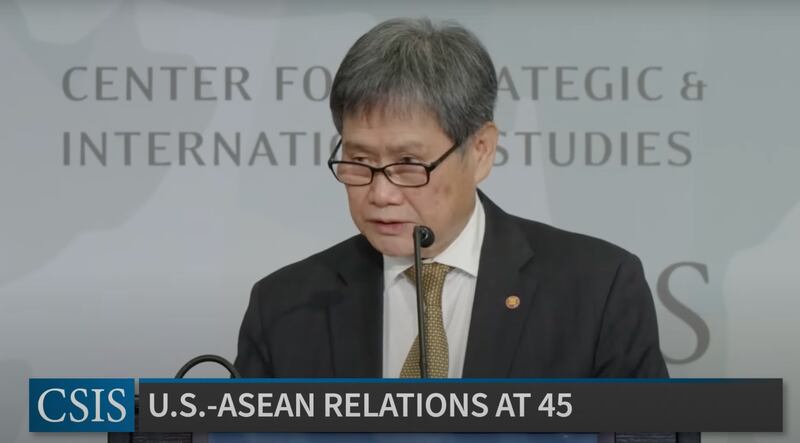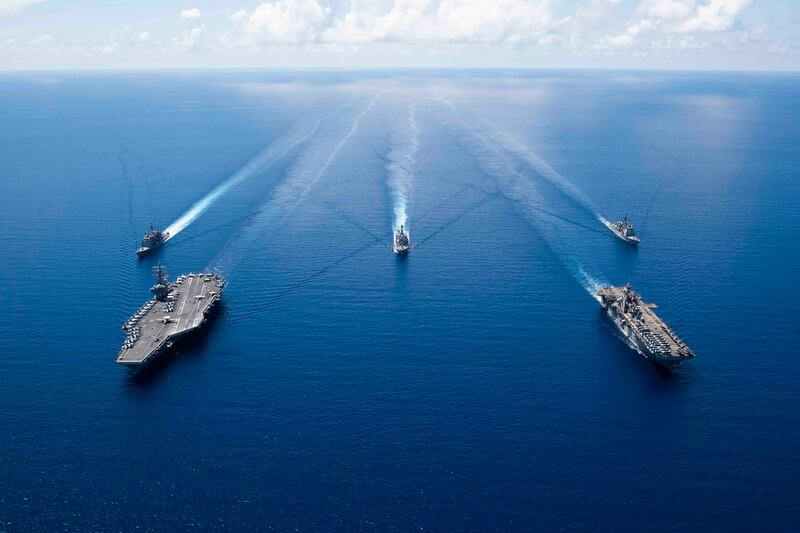The Association of Southeast Asian Nations (ASEAN) says it welcomes the U.S.’s role as an important partner but Washington should respect the existing regional architecture.
Bruneian Lim Jock Hoi, the bloc’s current secretary-general, said at a recent event at the Center for Strategic and International Studies (CSIS) in Washington D.C., that while the U.S. presence in the ASEAN region is important, it “should complement existing regional architecture that is open and inclusive.”
Its most senior official took part in a special discussion about the U.S-ASEAN partnership, hosted by the CSIS on Monday as its "inaugural" ASEAN Leadership Forum.
ASEAN is marking the 45th anniversary of its relationship with Washington this year.
“Peace and stability has always been a primordial concern of ASEAN since it was founded in 1967,” Lim emphasized.
U.S.-led initiatives such as the Indo-Pacific Economic Framework (IPEF) could provide opportunities to ASEAN countries, he said, but they “have to be in line with ASEAN’s outlook [on the] Indo-Pacific.”
“We stress, among others, ASEAN centrality, openness, transparency, inclusivity, making sure that all relevant actors in the region are included,” Lim said.

U.S. President Joe Biden announced in May the launch of the IPEF which comprises 13 nations but not China and which has been criticized by Beijing as a U.S. tool “to coerce regional countries.”
The U.S. continues to be the largest source of foreign direct investment in ASEAN and the second largest trading partner, with bilateral trade reaching U.S.$364 billion last year.
China's has remained ASEAN's number one trading partner for 13 consecutive years, according to the Chinese government's Information Office. Trade between China and ASEAN reached U.S. $544.9 billion in the first seven months of this year.
“We see both are important for ASEAN. We hope that both major powers discuss constructively in order to make the region more conducive to trade and investment and create opportunity for all of us,” the senior official said.
ASEAN’s neutrality
ASEAN’s leadership so far has been careful not to take sides in the U.S.-China rivalry in their backyard, said Kasit Piromya, former foreign minister of Thailand who has been active in ASEAN political circles.
“ASEAN should continue to maintain dialogue partnerships with both, reflecting that ASEAN is friendly and cooperative with all,” he said.
Officials from both ASEAN and the U.S. are working on the establishment of a so-called Comprehensive Strategic Partnership later this year. It is unclear how far-reaching the new form of partnership will become but the U.S. “needs to think more and do more” in terms of working with ASEAN, in Kasit Piromya’s opinion.
“I don't think that the U.S.-ASEAN relations have matured because there is no common base or foundation as such, unlike the U.S. relations with Japan, South Korea and Taiwan which are based on democracy,” he said.
“There seems to be no sense of real purpose and enthusiasm on the part of the U.S. side to really forge a more intensive and robust relationship with ASEAN in spite of the Indo-Pacific strategy and IPEF,” the former top Thai diplomat said.
Critics say that the ASEAN’s centrality was overlooked and bypassed when the U.S. put more efforts into other regional groupings such as the Quadrilateral Security Dialogue, or the Quad, that also includes Australia, India and Japan.
ASEAN was also not alerted or informed in advance of the setting up of AUKUS, the trilateral security pact between Australia, the United Kingdom, and the United States.
These Indo-Pacific security groupings are widely seen as countering China’s rising influence and assertiveness in the region.
“The U.S. has not fully utilized the inherent belief and desires of many of the ASEAN member states for its continued presence in the region,” Kasit said, adding: “Washington cannot fail to realize that all the countries in the region are afraid of China.”
South China Sea disputes
The U.S. has provided over U.S. $12.1 billion in development, economic, health, and security assistance to Southeast Asian allies and partners, including the members of ASEAN, since 2002, according to a U.S. State Department fact sheet.
“The United States supports the international rules-based order in the South China Sea, and in close cooperation with our allies and partners, the United States promotes a free and open Indo-Pacific in which the freedoms of navigation and overflight are enjoyed and respected by all states in accordance with international law,” the fact sheet reads.
China and several ASEAN member states hold conflicting claims over parts of the South China Sea but Beijing’s claims are the most expansive, up to 90% of the sea.
There was only a brief reference to the South China Sea disputes in the ASEAN secretary-general’s speech at CSIS on Monday, when Lim Jock Hoi listed maritime security as one of the challenges that the region has been facing “for the longest time.”
“Efforts towards the conclusion of the Code of Conduct on South China Sea, one [that] is mutually acceptable to all parties concerned, [have] effectively and consistently been pursued,” said Lim without mentioning the United States.
Some analysts believe that policy differences between ASEAN members in dealing with South China Sea issues led to a divisive approach to the role the U.S. could play.
The U.S. Navy, and maritime forces from the ten ASEAN countries held the first ASEAN-U.S. Maritime Exercise in Thailand in 2019 but the drills have not occurred again.
China has been warning against what it sees as “interference by external actors” in South China Sea disputes.
“Sometimes, the U.S. has come across as a little too keen to help, prompting concern among some claimants that it might inadvertently trigger an escalation of tensions or an unwanted incident in the South China Sea that Southeast Asian countries will have to bear the brunt of,” said Elina Noor, Director of Political-Security Affairs at the Asia Society Policy Institute in Washington D.C.
Noor said that the U.S. side could try to “have more effective communication and coordination with Southeast Asian partners so that their presence and shows of force don’t trigger misunderstanding.”

“ASEAN does not have common foreign policy goals, so member states have their own say regarding maritime cooperation,” said Nguyen The Phuong, a Vietnamese defense analyst.
“Some want more cooperation [with the U.S.], some want less.”
“There are also opinions that those countries which wish to cooperate more with the U.S. in the field of maritime security could set up a smaller group, unofficial of course, within ASEAN to bolster their cooperation,” he said.
In May, President Biden announced a new Indo-Pacific Partnership for Maritime Domain Awareness (IPMDA) that would provide better access to space-based, maritime domain awareness to countries across the region.
“It’s new, but a rising cooperation area,” said the Vietnamese analyst.
